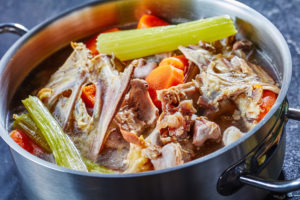Stock vs Broth vs Bone Broth
Inquiring minds want to know: Is it Granny’s homemade chicken broth that makes you feel better or the love that goes into making it? While we’re at it, what’s the difference between stock, broth and bone broth anyway? Which one is healthier? Which is better for cooking? How is stock, broth and bone broth made? The answers are about to be revealed, gentle reader! Although all of these liquids can be made with any kind of animal meat, I’ll be using chicken for this discussion…just because I like it so much!
If you’re like me, you probably thought they were all the same thing. To a point they are…but with slight differences in cooking and use.
What is broth?
In the old days, “broth” was the term used to describe any meat that was simmered in water. That meat could be chicken, beef, turkey, venison, seafood…you name it! Cooking time for broth is no more than a couple of hours or until the meat is cooked through. The meat is strained out and used for other purposes. So chicken broth would simply be chicken meat simmered in water with a little salt and pepper for seasoning. Because of the way it’s prepared, broth is thinner with a light flavor. But it makes an excellent base for homemade soups. It’s light flavor and consistency may be the reason most people reach for broth when they’re dealing with symptoms from cold or flu.
What is stock?
Stock is a step up from broth. It contains meat, vegetables and a few more seasonings. It’s cooked the same way as broth but has a more pronounced flavor than broth. Once strained, it can be used in soups, stews and sauces…really, just about anything! Because of it’s bolder flavor, this makes it a better option than plain water when preparing your favorite dish. Add stock to your next meal instead of water and let me know if you can taste the difference!
What is bone broth?
Not to confuse anyone, but bone broth is technically a stock. The terms have become interchangeable but the big difference is in cooking times. Bone broth is made using the whole animal…bones, skin, cartilage and marrow. Cooking time for bone broth is much longer and can take up to 24 hours or more. The longer cook time draws out the collagen in the bones which is what gives bone broth its thicker consistency. When chilled, collagen takes on a jiggly, gelatin-like texture. Don’t worry, this is perfectly normal. It will return to liquid form after heating. Among other things, collagen has been linked to improved joint and gut health as well as boosting the immune system. This makes bone broth a better choice than stock or broth…if you have the option.
LisasSimpleLife is a participant in the Amazon Services LLC Associates Program, an affiliate advertising program designed to provide a means for sites to earn advertising fees by advertising and linking to Amazon.com.
Broth or stock for cooking?
That depends on what you’re cooking. For the most part, stock and broth are interchangeable and can be used equally. However, there are a few food purists out there who will disagree. No matter which camp you fall into, most folks agree that stock is the go-to for enhancing flavor in most dishes.
Generally speaking, I like to use stock when making casseroles, homemade dumplings and chicken (or turkey) gravy. Once I stopped using water and replaced it with stock, my cooking went to a whole new level!
Since they’re interchangeable, you can’t go wrong by using either one. Just know that when it comes to a punch of flavor, the majority will reach for stock first.
Which is healthier…stock or broth?
Based on nutritional value, stock is definitely healthier. During the long cooking process, bone marrow and collagen are released along with all their nutrients. Thanks to the marrow and collagen, stock contains more vitamins and minerals than broth. But it’s also higher in calories. Broth, on the other hand, has fewer calories but less vitamins and minerals.
So, back to my original question: why does broth make you feel so much better when you’re sick? The answer is unclear and scientists admit they are still trying to figure it out! Either way, there is no denying that both are good for you. And they’re even better if they’re homemade!
Can you make stock from broth?
Technically, yes! But if you added any seasoning to your broth the first time you simmered it, you’ll need to go light on any additional seasonings. Pour the broth into a stock pot, add meat, meat bones, veggies and seasoning (if needed) and simmer for about two hours. I would advise against using a commercial broth to attempt making a homemade stock. When you consider that product and ingredient labels can be very deceptive and sodium content can get quite high, you might be more inclined to make it yourself.
I firmly believe the best kind of broth or stock to have in your pantry is one you make yourself! It’s really easy and the process is the same for both stock and broth with only a couple of minor differences.
How do you make broth?
For broth, simply add the meat or meat parts to a stock pot and cover with water. Add a pinch or two of salt and pepper. Bring the pot to a boil and reduce heat to a steady simmer. Simmer 1-2 hours or until the meat is cooked through. Using a coffee filter or several layers of damp cheesecloth, strain the liquid and pour into storage containers. Use the meat in another dish or chop it up and add some back to the broth to make a light homemade soup.
How do you make stock?
Stock is made using the same process but with the addition of bones, veggies and additional seasoning, if desired. Simmer for 2-4 hours or long enough to release the collagen from the bones. Strain and use just as you would broth.
How do you make bone broth?
As mentioned earlier, bone broth encompasses the whole animal carcass. Make sure everything is covered in water, bring to a boil, reduce heat and simmer for 24 hours or more for the best, healthiest bone broth. Just remember to keep an eye on the water level so it doesn’t evaporate. Most people will use a crock pot for this process since it doesn’t need to be babysat. It’s not absolutely required, but snapping the bones in half is believed to help release the collagen. All that’s left is to strain and enjoy.
Easy peasy…right!
It’s okay to cut corners when making stock and broth!
When it comes to the the meat and veggies for your broth and stock, you don’t have to buy anything! Many from-scratch cooks will tell you that creating a good broth or stock starts with saving your vegetable scraps, meat scraps and bones that would normally go in the trash. I’m talking food scraps that are safe to eat but may not be so pretty. For instance, I recently made a dish that required carrots, bell peppers and onions. Instead of throwing away the tops and leafy parts that I couldn’t use in that dish, I tossed them into a reusable ziploc bag which I keep in the freezer. When the bag gets full, I make broth or stock. It’s as easy as dumping the baggie into a stock pot. The bonus is that you don’t have to do any extra chopping or dicing when it comes time to fire up the stove! Since these scraps are going to the farm animals or the compost pile afterward, It doesn’t matter if they’re pretty or not. And imagine how much money you save by NOT buying all those ingredients!
You can use the bag method for meat and bone parts as well. Most people don’t eat the neck, back or inner parts from a chicken. But that doesn’t mean you should throw them away. Same goes for that take-out rotisserie chicken you picked up on your way home from work. Don’t forget the bones from steaks, ribs or even that turkey left over from the holidays. They can all go into a bag to be used later for bone broth.
Oh, and in case you’re wondering…you can make a vegetable broth as well. Simply delete the meat and bones!
A final thought…
Both broth and stock can be stored in airtight containers in the freezer for up to a year. Just make sure to leave at least an inch of head space to allow for expansion and make sure it’s had plenty of time to cool before placing in the freezer. If you’re not adverse to disposable freezer bags, stock and broth can be stored in them as well. Simply lay flat to freeze and then they can stand on end to save room in the freezer. Another old fashioned way to preserve this liquid gold is to pour it into canning jars and pressure can according to safe methods. You can find lots of websites that will explain how to do it safely.
Because there are no preservatives in homemade stock or broth, they should be used within a few days if stored in the fridge.
I’m all about getting back to basics and using what is on hand. Making homemade stock and broth uses up food scraps that might otherwise go to waste. It is so much healthier than anything you’ll find at the grocery store. Plus, it saves money! Boo-yah!!!
Why not try making your own stock or broth! Use it in place of water in your recipes. I guarantee you won’t regret it!
Until next time,
lisa
Original Post: Sep 24, 2018
Updated: Aug 15, 2023
Subscribe
If you like what you see, click on the subscribe button so you don’t miss anything!
I promise not to spam you! By clicking the subscribe button, you agree to my privacy policy.




I always wondered what the difference is.